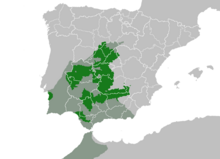Spanish Imperial Eagle
| Spanish Imperial Eagle | |
|---|---|
 | |
| Immature | |
| Conservation status | |
| Scientific classification | |
| Kingdom: | Animalia |
| Phylum: | Chordata |
| Class: | Aves |
| Order: | Falconiformes (or Accipitriformes, q.v.) |
| Family: | Accipitridae |
| Genus: | Aquila |
| Species: | A. adalberti |
| Binomial name | |
| Aquila adalberti C. L. Brehm, 1861 | |
 | |
| Synonyms | |
Aquila heliacea adalberti
| |
The Spanish Imperial Eagle, Iberian Imperial Eagle or Adalbert's Eagle (Aquila adalberti) is athreatened species of eagle that only occurs in central and south-west Spain, adjacent areas of Portugal and possibly northern Morocco although the latter is disputed. Formerly, the Iberian Imperial Eagle was considered to be a subspecies of the Eastern Imperial Eagle, but is now widely recognised as a separate species due to differences in morphology ,ecology, and molecular characteristics
The Spanish Imperial Eagle averages smaller, 2.5–3.5 kilograms (5.5–7.7 lb), 78–82 centimetres (31–32 in) in length and 180–210 centimetres (71–83 in) in wingspan, and darker than its eastern cousin, and is a resident species (Eastern Imperial is partially migratory). It feeds mainly onrabbits, but can prey on many other animals, such as partridges, rodents, hares, pigeons, crows,ducks and even small dogs. The species is classified as Vulnerable by BirdLife International and theIUCN. Threats include loss of habitat, human encroachment, collisions with pylons, and illegal poisoning. There has also been a decline in the rabbit populations, as a result of myxomatosis and other viral illnesses. The current population is estimated at less than 500.
In 2010, there were 279 in Spain and 3 pairs in Portugal, which is an increase of 16 pairs since 2009. Despite showing signs of recovery, it is still a globally threatened species. A small population is protected in Doñana National Park, Spain (descendants from only seven pairs in 1970: Schuhmacher, 1973) but its stronghold is the dehesa woodlands of central and south-west Spain, such as in Extremadura or Seville and Huelva Sierra Norte.
In February 2009, one male of the extremely small Portuguese population was shot.
The binomial commemorates Prince Adalbert of Bavaria.

No comments:
Post a Comment